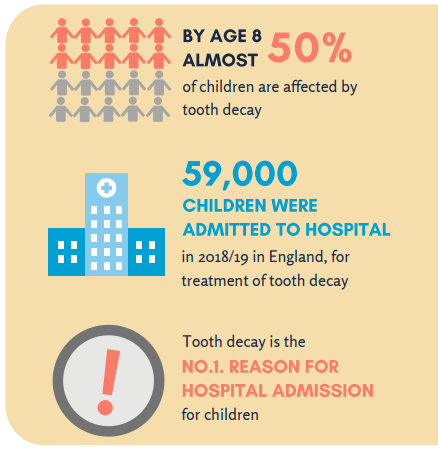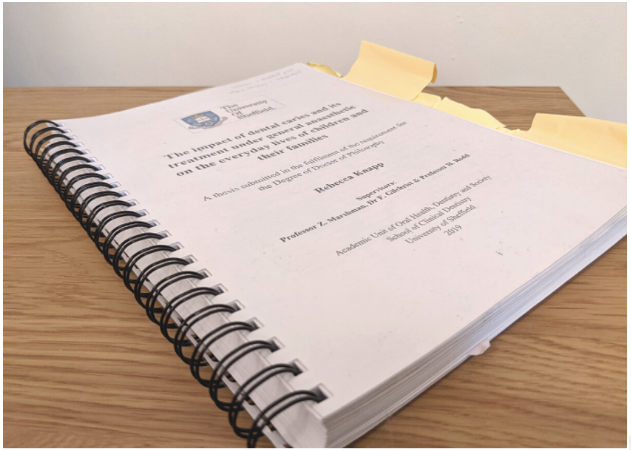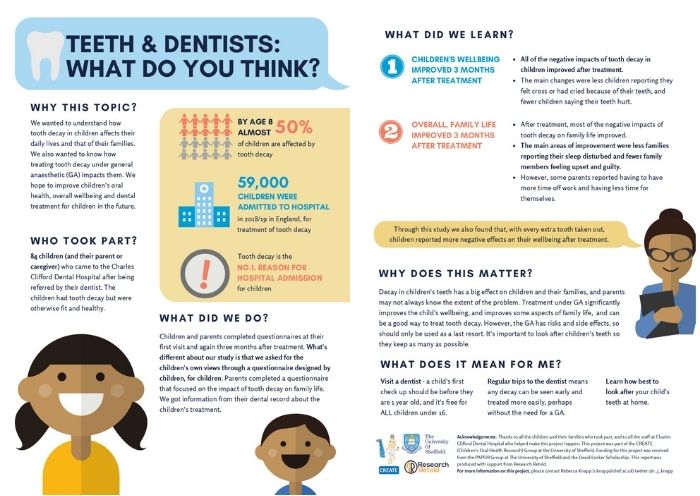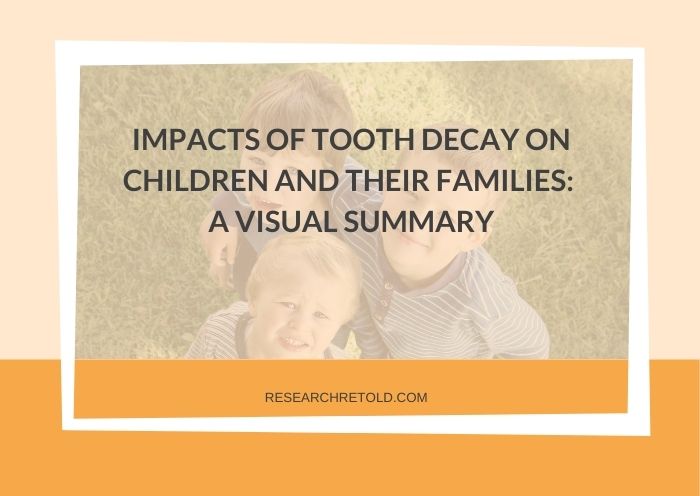Do you know the impact of tooth decay on children and their families’ wellbeing?
In this blog, we share the insights produced by the PhD research of Rebecca Knapp (@r_j_knapp) on this topic. She is a student at the Person-centred and Population Oral Health | Clinical Dentistry | The University of Sheffield.
Becky collaborated with Research Retold to produce a visual summary to better engage with the participants in her study.
If you want to know about her experience during this creative process, keep on reading for her testimonial.
What is tooth decay?
Tooth decay is ‘damage to a tooth caused by dental plaque turning sugars into acid’ (NHS, 2021). The microorganisms living in the mouth consume sugars from the food residues and transform them into acids, debilitating and ultimately dissolving the enamel that protects the tooth.
Impact of tooth decay on children and their families

Did you know that 50% of children older than 8 have been affected by tooth decay? This ailment is actually the No.1 reason for hospital admissions for children. Between 2018-2019, 59,000 children were admitted to the hospital for tooth decay treatment in England.
Recommendations
There are three main actions you can take to prevent tooth decay in your children:
- Visit a dentist. If you think there is an issue, go to the experts.
- Do regular trips to the dentist. Having regular checks can detect potential problems in their initial stages when it is easier to intervene.
- Learn how to best look after your child’s teeth at home. You can ask your dentist for advice and set healthy habits. For example, children should brush their teeth twice a day, especially before bedtime.
About the research
During my PhD, I wanted to discover the effect of tooth decay on children and their families’ everyday life. Research to date in this area relies on parental reports. Thus, we knew little about how children are impacted from their own point of view.
My research used a special questionnaire designed by children, for children, to learn how tooth decay impacted them day-to-day. I also looked at the effect that treatment under general anaesthetic had on these children and their families.
Why did I choose to create a visual summary?
As for most PhD students, my research was first published as a doctoral thesis. Later on, it was published in an academic journal.
However, I wanted to communicate my research to audiences outside of academia, and specifically with the families who had taken part in the research. This left me with a problem:
How do I turn a 250-page thesis into a widely understood and interesting summary?
The Research Retold Workshop
Fortunately, the solution to the problem presented itself. It came in the form of a two-day workshop by Research Retold and ran by its founder, Mihaela Gruia. Incredibly, this workshop was completely free for me as a participant – thanks to my University for investing in these kinds of skill-building activities!

The workshop titled ‘Communicating Research Beyond Academia’ took me through the process of producing a 2-page visual summary of my research. One of the highlights of the workshop was looking at visual summaries examples. These had been produced by Research Retold for other researchers. It was great to see how these combined visual elements and text clearly communicate the key messages of the research effectively.
Due to COVID-19 restrictions, we were unable to meet in person; but it was not a problem. Mihaela ran the interactive workshop on Zoom, and I can honestly say it was one of the most engaging, effective workshops I have ever been to, remotely or in person!
Creating my visual summary about the impact of tooth decay on children and their families
The challenge for me was being asked to think about what was important in my research for the intended audience. The high-level statistical analysis in my thesis fascinates me. But how can I make it relevant to other people? For example, to the parent of a 6-year-old child who had to go to the hospital for tooth decay treatment? I quickly learned to identify the key messages in my work and the implications for those who took part in the project.
I continued with drafting a two-page visual summary on Canva and submitted it for feedback two weeks later. This process was incredibly useful. It highlighted aspects that were unclear to someone new to the research and helped me identify little improvements to make more impact, for example, consistency in colours.
The result
From this

To this

I am pleased with my final summary. I plan to disseminate through social media and send a copy to every participant in the study. Hopefully, it provides them with a clear idea of what our research showed, as well as giving them practical implications of the work.
What I learned from creating a visual summary
Importantly, I learned some valuable lessons in the process of creating my visual summary:
- Remember the audience: It was so easy to slip back into scientific language or focus on what I found most interesting. Ensuring the language and focus is appropriate is vital to good communication!
- What do I want them to know and what would they like to know? It was so important to have these things clear to ensure key messages were conveyed.
- Visuals VS SPACE: Images or graphs can really add to the overall appearance. They can help to communicate the message. I also learned how important white space is for keeping something readable! Sometimes less is more.
- Call to action: so simple and easy to forget. I was reminded of how important it is to answer the questions: “So what?”, “What does this research mean for the audience and what should they do in response?”
Conclusions
I would highly recommend the Research Retold workshop or reading their Guide to Communicating Research Beyond Academia, to learn more about communicating research outside of academia.
I feel so much more aware of the best ways to do this, and also about what things are important to consider. Now I am more aware of how to share research. Networks and social media can be great options, and visual summaries can be very effective in these environments.
Finally, a massive thank you to Mihaela at Research Retold. I appreciate her advice and support through this workshop and subsequent feedback.
If you are interested in how tooth decay impacts children and their families or if you’d like to receive a copy of my visual summary you can email me at r.knapp@sheffield.ac.uk.
